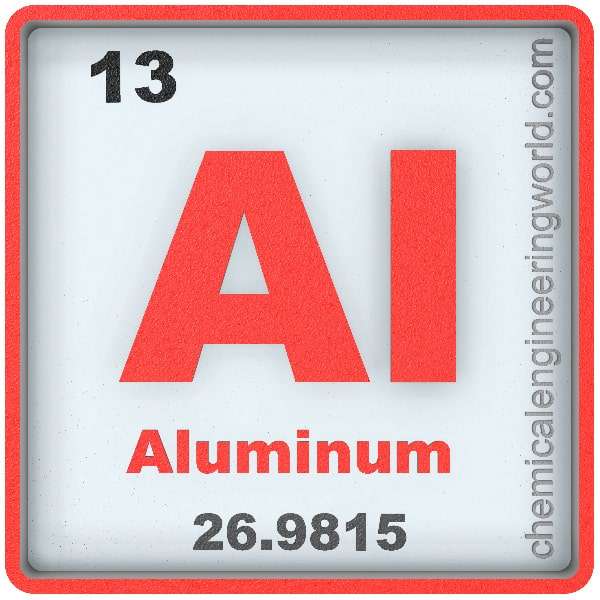Aluminium Element Properties and Information

Aluminium Element Properties and Information:
Aluminium is thirteenth element on the periodic table. Elements are arranged in the periodic table on the basis of the atomic number. Atomic number is the number of protons in the nucleus of the atom. Aluminium has an atomic number of 13. It is located in the Group 13 and Period 3 of the periodic table of elements. It is denoted by Al. The name is derived from the Latin word ‘Alumen’ meaning Bitter Salt.
Hans Christian Oersted was the first person to produce the elemental aluminium in 1825 by heating aluminium chloride with potassium although the obtained aluminium was impure. Friedrich Wöhler improved upon his method in 1827 and produced pure aluminium by using sodium instead of potassium.
Aluminium is the third most abundant element on earth after oxygen and silicon and is the most abundant element present in the earth’s crust. It makes up about 8.1% of the total earth’s crust. Aluminium is usually found in combined forms in nature. Aluminium silicate minerals like bauxite and cryolite are common sources of aluminium.
Physical Properties:
- Aluminium is silvery white, light weight metal which is soft and malleable.
- The atomic mass of aluminium is 26.981
- The melting point of aluminium is 660.4°C
- The boiling point of aluminium is 2467°C
- The density of aluminium is 2700 in S.I. units at 20°C
- Among all the isotopes of aluminium only aluminium-27 is the stable isotope.
- Aluminium is light and soft but if mixed with other metals in proper proportions it can be made to be hard while still retaining its hardness.
- Aluminium is am excellent thermal and electrical conductor.
- Aluminium acts as a superconductor at 1.2 K.
- Aluminium is unaffected by static magnetic fields because it is paramagnetic in nature.
Chemical Properties:
- Aluminium is a highly reactive metal due to which it is not found in nature in Free State.
- When aluminium is exposed to air, a layer of oxide forms on the surface. This layer is very stable hence it cannot be easily scrapped off of the surface like iron rust.
- Aluminium reacts with most nonmetals on heating. It is capable of forming aluminium nitride, aluminium sulfide and also aluminium halides.
- Aluminium forms various coordination compounds.
- Aluminium forms organoaluminium compounds like aluminium tryalkyls and tryaryls and also hydrides like lithium aluminium hydride.
Methods of Production:
- Bayer process: Bauxite is blended uniformly and mixed with sodium hydroxide and sent to a digester. Aluminium hydroxide gets dissolved in the bauxite. The bauxite residues are separated and the aluminium hydroxide is converted to aluminium oxide by heating.
- Hall-Héroult process: This is an energy intensive process. A solution of alumina in a molten mixture of cryolite with calcium fluoride is electrolyzed to produce metallic aluminium. The temperatures lie between 950 to 980°C.
Relevance in Chemical and Related Industries:
- Catalyst: Triethylaluminium are used as catalysts for low pressure polymerisation of ethane and propane.
- Water treatment: A compound of aluminium, aluminium sulfate is widely used for the purpose of treatment of water.
Relevance in Other Industries:
- Transportation: Aluminium alloys are widely used in aircraft industries and as well as ships, cars, trucks etc to make the structure of the vehicles because of its light weight and good mechanical properties.
- Electrical and Electronics Industries: Aluminium is cheap, widely available, good conductor of electricity and heat, has good electrical and mechanical properties due to which it is used to make motors, generators, conductor alloys, transformers etc.
- Machinery: Aluminium is used in making processing equipments, tools and pipings because it is corrosion resistant, non-pyrophoric and has good mechanical strength when combined with other metals in proper proportions.
- Medicine: Certain aluminium salts serve as immune response boosters in vaccines to allow the protein in the vaccine to achieve sufficient potency as an immune stimulant.
Health Effects on Exposure:
- Over Uptake: Aluminium has no significant biological role to play in human body thus it is not required to be intake but aluminium can enter body through food or by working in an environment where aluminium is present in air, over concentration of aluminium in human body causes damage to the central nervous system, dementia, loss of memory and severe trembling.
- Inhalation: People working in aluminium factories can develop lung and kidney problems. Shaver’s disease may also occur on prolonged exposure.
Effects on Surroundings:
- Water life: If concentration of aluminium ions increases in water body then the aluminium ions reacts with proteins present in the gills of fishes and also embryos of frogs, hinder their biological mechanism and cause their death. Aluminium reacts with phosphates and causes phosphates to be less available to the water organisms.
- Inhalation: If birds inhale aluminium through air then the effect is that the egg shell thickness decreases and the weights with which chicks are born also decreases. If animals inhale aluminium through air then it causes lung problems to them and thus decline in activity.
References:
































